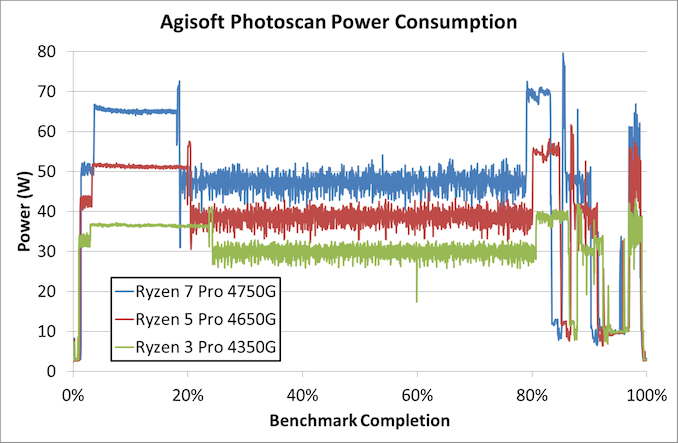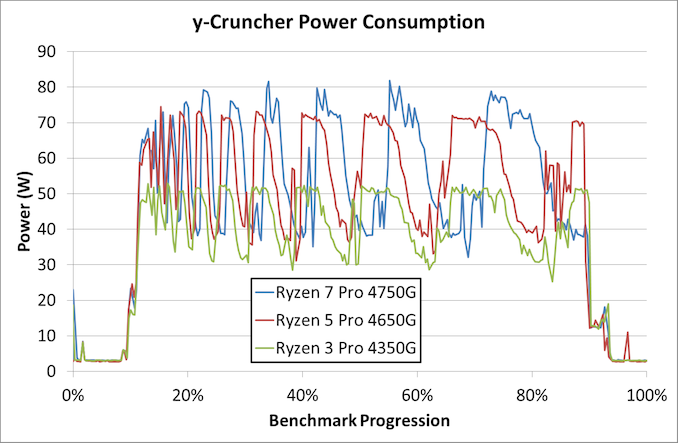Testing The World’s Best APUs: Desktop AMD Ryzen 4750G, 4650G and 4350G
by Dr. Ian Cutress on December 16, 2020 10:30 AM ESTPower Consumption
The nature of reporting processor power consumption has become, in part, a dystopian nightmare. Historically the peak power consumption of a processor, as purchased, is given by its Thermal Design Power (TDP, or PL1). For many markets, such as embedded processors, that value of TDP still signifies the peak power consumption. For the processors we test at AnandTech, either desktop, notebook, or enterprise, this is not always the case.
Modern high performance processors implement a feature called Turbo. This allows, usually for a limited time, a processor to go beyond its rated frequency. Exactly how far the processor goes depends on a few factors, such as the Turbo Power Limit (PL2), whether the peak frequency is hard coded, the thermals, and the power delivery. Turbo can sometimes be very aggressive, allowing power values 2.5x above the rated TDP.
AMD and Intel have different definitions for TDP, but are broadly speaking applied the same. The difference comes to turbo modes, turbo limits, turbo budgets, and how the processors manage that power balance. These topics are 10000-12000 word articles in their own right, and we’ve got a few articles worth reading on the topic.
- Why Intel Processors Draw More Power Than Expected: TDP and Turbo Explained
- Talking TDP, Turbo and Overclocking: An Interview with Intel Fellow Guy Therien
- Reaching for Turbo: Aligning Perception with AMD’s Frequency Metrics
- Intel’s TDP Shenanigans Hurts Everyone
In simple terms, processor manufacturers only ever guarantee two values which are tied together - when all cores are running at base frequency, the processor should be running at or below the TDP rating. All turbo modes and power modes above that are not covered by warranty. Intel kind of screwed this up with the Tiger Lake launch in September 2020, by refusing to define a TDP rating for its new processors, instead going for a range. Obfuscation like this is a frustrating endeavor for press and end-users alike.
However, for our tests in this review, we measure the power consumption of the processor in a variety of different scenarios. These include full AVX2/AVX512 (delete as applicable) workflows, real-world image-model construction, and others as appropriate. These tests are done as comparative models. We also note the peak power recorded in any of our tests.
First up is our image-model construction workload, using our Agisoft Photoscan benchmark. This test has a number of different areas that involve single thread, multi-thread, or memory limited algorithms.
Each of our three processors here seems to approach different steady state power levels for the different areas of the benchmark.
- The 8-core is around 65 W in the first stage, and more around 48 W in the second stage.
- The 6-core is around 51 W in the first stage, and more around 38 W in the second stage.
- The 4-core is around 36 W in the first stage, and more around 30 W in the second stage.
The fact that the difference between each of the processors is 14-15 W in the first stage would go a little to suggesting that we're consuming ~7 W per core in this part of the test, which is strictly multi-threaded. However when it moves more into variable threaded loading, all three CPUs are well below the TDP levels.
The second test is from y-Cruncher, which is our AVX2/AVX512 workload. This also has some memory requirements, which can lead to periodic cycling with systems that have lower memory bandwidth per core options.
The y-Cruncher test is a little different, as we're mostly concerned about peaks. All three CPUs have a TDP rating of 65 W, however the 8-core here breaches 80 W, the 6-core is around 72 W, and the only processor below that TDP value is the quad core Ryzen 3.
For absolute peak power across all of our tests:

For absolute instanteous peak power, each of the Ryzen R4000 APUs does what was expected - with the Ryzen 7 hitting the socket limit for 65 W processors.












104 Comments
View All Comments
NedHej - Wednesday, December 16, 2020 - link
Why, for the integrated tests, are you showing 360pMin and 1080pMax?One of those I'm never going to use, and the other I'm not going to expect an IGPU to deliver.
Sure the 1080pMax is good to know but why not pick something sensible, like 1080pMin or 720pMedium, to suggest a setup people might actually want to know about?
lucasdclopes - Wednesday, December 16, 2020 - link
I entered the comment section to say the same thing. For IGP 1080pmax is too much but 360p/600plow is too little. Needs a 768p medium.StevoLincolnite - Wednesday, December 16, 2020 - link
Yeah. Also agree. 720P is what I would be targeting if I intend to game on integrated graphics.360P/480P and 1080P are not my use cases/expectations.
n13L5 - Saturday, January 16, 2021 - link
Yeah, this test was done for or by a theoretical person, not a gamer, who would want to use values that give them an idea if it was going to be useful for gaming or not.I also missed the GTX 1650, just to see how APUs compare to the cheapest *modern* card you can buy at $160 or so (unless there's a bitcoin mining boom).
Granted, if you buy an $160 GPU, and keep in the price range of the 4750G, you'd need to find a used i5-7xxx or so on eBay for under $100.
But that would surely run better than anything they tested here, other than the GTX-1080...
jakky567 - Sunday, December 20, 2020 - link
I'd argue 768p is a weird resolution in context of these chips, as I'd expect them to be used with an external display. In games, if you're using a lower resolution, I think 720p makes more sense anyhow.n13L5 - Wednesday, December 30, 2020 - link
True.Even though, people do play and benchmark these on YT @1080p with somewhat reduced settings.
Its not horrible looking, but obviously no ray tracing there...
ricebunny - Wednesday, December 16, 2020 - link
Tests “World’s best APUs”, but does not include Apple M1??Tomatotech - Wednesday, December 16, 2020 - link
I admire the M1 but it isn’t an APU. That APU name is just AMD’s branding and only applies to their chips.(intel’s IGPUs aren’t tested here either.)
nandnandnand - Wednesday, December 16, 2020 - link
Hogwash. If Intel makes a CPU with a faster iGPU than AMD, then it's a better APU. Period.Technically, the Xbox Series X and PS5 have the world's best APUs. But good luck running your own OS on them.
ricebunny - Wednesday, December 16, 2020 - link
Actually, the review does include a soldered Intel iGPU of Tiger Lake family. Plus a Broadwell family desktop CPU.@Ian: Can you specify in more detail per game what the max settings are?
Assuming that for Civ6 that means Ultra settings (by default without AA), I get 33 FPS on the M1 mini. That's 65% faster than the 4750G and entirely playable.